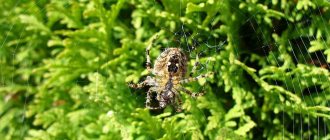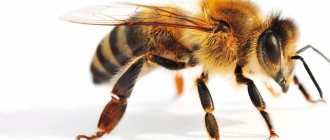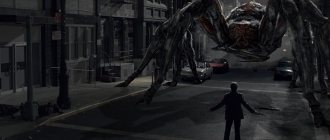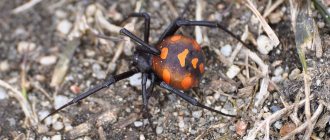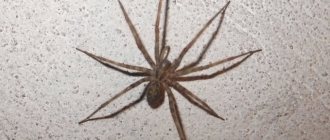How is a spider different from insects?
Although spiders, like insects, belong to the class of arthropods, they are not insects. Spiders belong to the class Arachnida, insects belong to the class Insects.
See the main differences between these two types below:
Spider
- 8 legs;
- the body consists of two parts, the head connected to the chest (cephalothorax) and the abdomen;
- jaws have cutting properties;
- spiders cannot fly;
- Spiders don't have antennae.
Insects
- 6 legs;
- the body consists of three parts: head, chest and abdomen;
- jaws are suitable only for chewing or crushing food;
- many insects have wings, and many of them can fly;
- insects have two antennas on their heads.
Zophobas beetle
The usual size of a spider ranges from a few millimeters to 10 centimeters. But there are certain species, for example Goliath tarantula spiders, which can reach a size of up to 30 centimeters.
In spiders, the body is divided into two clearly distinguishable regions: the cephalothorax, known as the prosoma (anterior part), and the abdomen, known as the opisthosoma (posterior part). All other parts of the animal are connected to the cephalothorax; these are eight legs, two chelicerae and two pedipalps.
Brachypelma Smitty top view
Chelicerae belong to the oral part, and are used for feeding and obtaining food. In most spiders, these chelicerae are associated with glands that secrete venom, which is used to paralyze or kill prey.
The pedipalps are similar to legs, but never touch the ground because they are shorter than the legs. They serve for reproduction as a copulatory device for introducing sperm into the female's body.
In the back of the spider there are glands that produce silk, which is used to make webs. All types of spiders have this property and they need it to capture prey and immobilize it and store it, they build a shelter from it and wrap their future offspring in it.
We recommend: Brachypelma spider, description, maintenance and care
The digestive system consists of the pharynx and stomach in the cephalothorax, and the intestines in the abdomen. At the top of the opisthosoma is the heart. Spiders respire through lungs known as phylotrachea.
The spider's digestion is external; having caught prey, it injects poison into it, which paralyzes or kills it, and then injects digestive juice into it. This juice turns the victim into a mushy state, which the spider then happily consumes.
Spiders use pedipalps for smell and touch.
Unlike insects, most spiders have poor vision, even though they have 2 to 8 eyes, this does not help them much, but there are some species with good vision, such as jumping spiders.
External structure
The body structure of a spider may vary slightly depending on the species. The size of the arthropod can range from a few millimeters to 30 cm.
The spider's body is divided into a cephalothorax and abdomen, connected to each other by a stalk. These two sections are clearly distinguishable visually. The outer chitinous shell that covers the insect's body is called the exoskeleton.
It includes:
- chitin.
- Protein sclerotin.
The body parts of spiders are covered with a chitinous layer that protects the body from mechanical damage and drying out. The chitinous shell is not capable of changing its size, so the spider periodically changes it to a new one.
The abdomen is covered with more elastic skin, due to which it is able to significantly increase in size after a meal.
All the limbs of the spider are attached to the cephalothorax or prosoma. On the carapace (anterior part of the prosoma) there are several pairs of eyes. The sternum (lower part of the cephalothorax) contains the lower and upper lips. Immobile chelicerae are attached to them. They consist of one segment, to which movable sharp fangs are attached.
Venom ducts approach the fangs. On the sides of the prosoma there are coxae to which the limbs are attached. They are not protected by chitin, thanks to which the spider is able to move quickly and deftly.
Spiders have 6 pairs of limbs:
- 1 pair of chelicerae;
- 1 pair of pedipalps;
- 4 pairs of walking legs.
The pedipalps consist of 6 segments. They serve for orientation in space. Mature males develop cymbiums at their ends, with the help of which they fertilize females. In large species, the pedipalps are quite long, and therefore they are often mistaken for another pair of walking limbs.
Each walking leg consists of 7 segments connected by joints.
They have the following names:
- paw.
- Forefoot.
- Shin.
- Cup.
- Hip.
- Trochanter.
- Basin.
The abdomen is also called opisthosoma or abdomen. At its end there are two processes, which are arachnoid appendages. Below them is the anus.
Distribution and habitat
Spider in the forests of Russia
Spiders live on all continents except Antarctica. Being invertebrate animals, they cannot control their body temperature and are susceptible to cold, however, in northern Canada, Greenland and northern Russia they get along well.
They are one of the few species of animals that get along well in the highlands. There are certain species that feel great even in an aquatic environment.
The main factor that limits their habitat is the availability of food.
What do spiders eat and how do they reproduce?
Spiders are predatory animals and good hunters. When hunting, they can use a variety of methods, from passively sitting near traps built from webs, to actively searching and tracking their prey.
Male spiders have a complex courtship ritual, but it consists mainly of trying to avoid being captured by a female spider, which is much larger in size, and using the pedipalps to introduce their sperm into the female’s reproductive tract. And the most important thing is to try to survive in this process by avoiding the bite of the female; unfortunately, few people succeed in this.
Little baby spider Brachypelma Smitty
As a result of fertilization, the female lays up to 3000 eggs. In some species of spiders, the females die immediately after laying eggs, while some species fiercely defend them until hatching. Spiders go through the entire larval stage in eggs, and are born as small spiders.
We recommend: 7 interesting facts about crocodiles
Internal structure
The structural peculiarity of arachnids is noticeable in the organization of the body cavity. It is a connection between the primary and secondary cavities. The body is filled with hemolymph. The heart is located in the dorsal part of the abdomen and looks like a long tube. Blood vessels branch off from it. The circulatory system is open.
Spiders' blood is colorless.
The respiratory organs are represented by:
- trachea;
- lung sacs.
Breathing is adapted to life on land. Spiders breathe using tracheas, which resemble two long tubes with numerous holes. Through them, oxygen flows to the internal organs.
The digestive system consists of:
- mouth;
- throats;
- stomach;
- foregut, midgut and hindgut;
- cloaca.
The excretory system of arachnids is arranged in an unusual way. The excretory organs are two Malpighian vessels. These are tubes with one end extending into the internal cavity of the body and the other into the intestines. Waste substances penetrate through the walls of blood vessels. The end products are excreted, and the liquid remains inside the body. Thus, spiders retain moisture and can live in dry conditions for a long time.
Let's study what kind of nervous system arachnids have. It is called nodular because the main center forms 5 pairs of nerve ganglia. A nerve chain runs along the abdomen.
Sexual reproduction involves males and females. Females are larger in size and often eat their partner. After fertilization, the female lays eggs and weaves a cocoon around them.
Rice. 2 Cocoon
The maximum number of eggs is 20 thousand pieces.
After the offspring appear, the mother looks after it for some time. The development of the young depends on the variety.
Why are spiders important to humans?
Spider web has unique properties in terms of flexibility, strength and long service life; in these parameters it is superior to various modern synthetic fibers and even steel. For this reason, many researchers mainly work and study this material abroad.
Spider web
Scientists at the prestigious Massachusetts Institute of Technology are working with the web of the golden silk spider. This species is capable of catching birds in its web, and from its web, for many centuries, fishermen from the South Pacific Ocean have woven nets to catch fish.
Today, scientists are exploring silk from the spider's glands for medical purposes and for making tendons and prosthetic ligaments, creating surgical thread for operations, and creating lightweight and durable fabrics for parachutes or body armor.
General characteristics. External structure
The cross spider can be found in the forest, park, and on the window frames of village houses and cottages.
Most of the time, the spider sits in the center of its trapping network of adhesive thread - cobweb. The spider's body consists of two sections: a small elongated cephalothorax and a larger spherical abdomen. The abdomen is separated from the cephalothorax by a narrow constriction. Four pairs of walking legs are located on the sides of the cephalothorax. The body is covered with a light, durable and quite elastic chitinous cover.
The spider periodically moults, shedding its chitinous cover. At this time it is growing. At the anterior end of the cephalothorax there are four pairs of eyes, and below there is a pair of hook-shaped hard jaws - chelicerae. With them the spider grabs its prey.
There is a canal inside the chelicerae. Through the channel, poison from the poisonous glands located at their base enters the victim’s body. Next to the chelicerae there are short organs of touch, covered with sensitive hairs - the tentacles.
At the lower end of the abdomen there are three pairs of arachnoid warts that produce cobwebs - these are modified abdominal legs.
The liquid released from arachnoid warts instantly hardens in air and turns into a strong web thread. Different parts of arachnoid warts produce different types of webs. Spider threads vary in thickness, strength, and adhesiveness. The spider uses different types of web to build a trapping network: at its base there are stronger and non-sticky threads, and concentric threads are thinner and stickier. The spider uses webs to strengthen the walls of its shelters and to make cocoons for eggs.
Interesting facts about spiders
- Some species of arachnids exhibit kleptoparatism, which is when they steal prey from other spiders instead of hunting on their own;
- The spider plays an important role on the planet in the fight against a large number of harmful insects;
- In Cambodia, eating certain types of arachnids is part of the national cuisine; they are fried in oil and eaten as a snack.
- After forest fires, spiders are the first to appear in the forests in the burned areas, and they begin to regenerate the dead area of the forest. Interesting fact: in 1883, the first living creature that scientists discovered after the devastating eruption of the Krakatoa volcano (Indonesia) was a spider.
So if you cross paths with a spider, don't kill or harm it. He has a lot of work to do.
